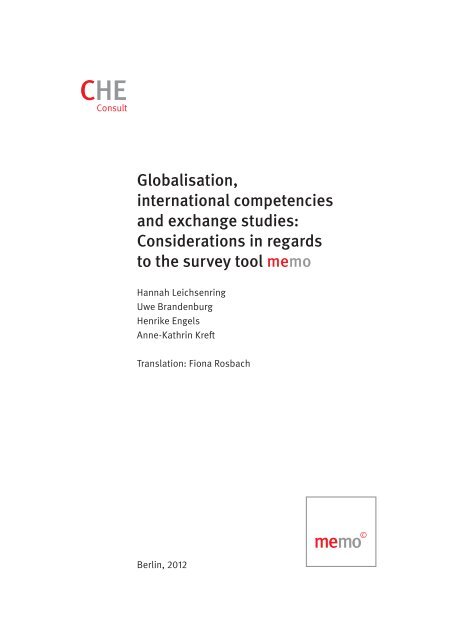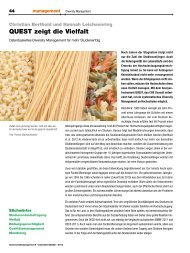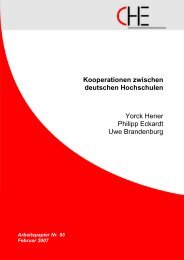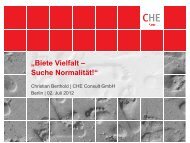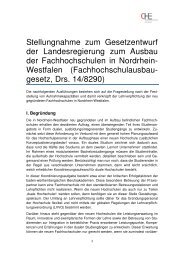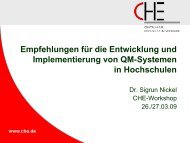Considerations in regards to the survey tool memo - CHE Consult
Considerations in regards to the survey tool memo - CHE Consult
Considerations in regards to the survey tool memo - CHE Consult
You also want an ePaper? Increase the reach of your titles
YUMPU automatically turns print PDFs into web optimized ePapers that Google loves.
Globalisation,<br />
<strong>in</strong>ternational competencies<br />
and exchange studies:<br />
<strong>Considerations</strong> <strong>in</strong> <strong>regards</strong><br />
<strong>to</strong> <strong>the</strong> <strong>survey</strong> <strong>to</strong>ol <strong>memo</strong><br />
Hannah Leichsenr<strong>in</strong>g<br />
Uwe Brandenburg<br />
Henrike Engels<br />
Anne-Kathr<strong>in</strong> Kreft<br />
Translation: Fiona Rosbach<br />
Berl<strong>in</strong>, 2012
Moni<strong>to</strong>r<strong>in</strong>g Exchange Mobility Outcomes<br />
Without a doubt, <strong>in</strong>ternationalisation is currently<br />
en vogue: Especially <strong>in</strong> <strong>the</strong> higher education sec<strong>to</strong>r<br />
efforts are be<strong>in</strong>g made <strong>to</strong> implement <strong>in</strong>ternationalisation<br />
strategies <strong>in</strong> manifes<strong>to</strong>s, strategy plans and<br />
university profiles. National and European <strong>in</strong>stitutions<br />
give massive f<strong>in</strong>ancial support <strong>to</strong> <strong>the</strong>se developments.<br />
The ERASMUS exchange programme alone<br />
has a volume of 7bn Euro (programmes from 2007 -<br />
2013). But what exactly are <strong>the</strong> reasons for promot<strong>in</strong>g<br />
<strong>the</strong> <strong>in</strong>ternationalisation of education?<br />
The <strong>in</strong>ternationalisation of teach<strong>in</strong>g is unanimously<br />
considered “good”. Internationalisation professionals<br />
mostly work on <strong>the</strong> basis of a concept of <strong>in</strong>ternationalisation<br />
that is reflected <strong>in</strong> e.g. Jane Knight‘s<br />
def<strong>in</strong>ition (Knight, 1993), which characterises <strong>the</strong><br />
<strong>in</strong>ternationalisation of <strong>the</strong> higher education sec<strong>to</strong>r <strong>in</strong><br />
four ways:<br />
- As a process<br />
- As a resource<br />
- As a means <strong>to</strong> align <strong>the</strong> higher education system<br />
with <strong>in</strong>ternational standards and also as<br />
- A chance <strong>to</strong> create a system that is open <strong>to</strong> a globalised<br />
environment (separate from <strong>the</strong> globalisation<br />
process).<br />
In <strong>the</strong>ir paper The End of Internationalization?, published<br />
<strong>in</strong> 2011, Uwe Brandenburg and Hans de Wit critically<br />
reflect on <strong>the</strong>se generally undisputed presumptions<br />
(Brandenburg & de Wit, 2011). They reject<br />
Knight’s def<strong>in</strong>tion and claim that <strong>in</strong>ternationalisation<br />
and globalisation are used <strong>in</strong> <strong>the</strong> current debate as<br />
antagonistic term<strong>in</strong>i, whose respective mean<strong>in</strong>gs are<br />
contentious or, ra<strong>the</strong>r, have become devalued. One<br />
often says globalisation, when one actually means<br />
neoliberalism, <strong>the</strong> currently predom<strong>in</strong>at<strong>in</strong>g economic<br />
paradigm.<br />
Especially <strong>in</strong> recent days, as de Wit argues <strong>in</strong> his<br />
critical comment from 2011 (de Wit, 2011), ever new<br />
labels for <strong>in</strong>ternationalisation are <strong>in</strong>troduced <strong>to</strong> <strong>the</strong><br />
debate, e.g. <strong>the</strong> term “comprehensive <strong>in</strong>ternationalization”,<br />
which John Hudzik (Hudzik, 2011) presented<br />
<strong>in</strong> <strong>the</strong> same year. De Wit po<strong>in</strong>ts out that this new label<br />
did not conta<strong>in</strong> any new dimensions of <strong>in</strong>ternationalisation<br />
but <strong>in</strong>stead relates back <strong>to</strong> <strong>the</strong> commonly<br />
established def<strong>in</strong>ition by Knight (Knight, 1993). In<br />
<strong>regards</strong> <strong>to</strong> fur<strong>the</strong>r def<strong>in</strong>itions <strong>the</strong> tendency <strong>to</strong>wards<br />
repetitions and a lack <strong>in</strong> content is similarly noticeab-<br />
www.<strong>memo</strong>-<strong>to</strong>ol.net<br />
le: „There is no o<strong>the</strong>r conclusion but that <strong>the</strong>se labels<br />
are tau<strong>to</strong>logies, us<strong>in</strong>g different words <strong>to</strong> say <strong>the</strong> same<br />
th<strong>in</strong>g even if <strong>the</strong> repetition does not actually make <strong>the</strong><br />
mean<strong>in</strong>g even clearer.” (de Wit, 2011)<br />
Brandenburg and de Wit demand for <strong>the</strong> term or<br />
ra<strong>the</strong>r for <strong>the</strong> concept Internationalisation <strong>to</strong> be filled<br />
with new mean<strong>in</strong>g, for its value <strong>to</strong> be re<strong>in</strong>stated and<br />
fur<strong>the</strong>rmore <strong>to</strong> question, which means and activities<br />
are utilised as part <strong>in</strong> <strong>the</strong> <strong>in</strong>ternationalisation processes<br />
of HEIs and why <strong>the</strong>se <strong>in</strong> particular. Although <strong>the</strong><br />
future of HEIs will doubtlessly have a global or, as <strong>the</strong><br />
case may be, <strong>in</strong>ternational character: “Called for is a<br />
common commitment at <strong>the</strong> <strong>in</strong>stitutional and personal<br />
level of how we and our students will be prepared<br />
<strong>to</strong> live and work <strong>in</strong> a global community” (Brandenburg<br />
& de Wit, 2011, p. 17).<br />
Hereby <strong>the</strong> concern is not only for <strong>the</strong> scientific, but<br />
also for <strong>the</strong> cultural context: In this regard, <strong>the</strong> acquisition<br />
of <strong>in</strong>tercultural competencies has <strong>to</strong> be<br />
seen as an important strategy for <strong>the</strong> preparation for<br />
liv<strong>in</strong>g and work<strong>in</strong>g with<strong>in</strong> a globalised world whose<br />
complexity should not be underestimated and was<br />
described by Hofstede (Hofstede, 2009). Intercultural<br />
competencies are <strong>the</strong>refore an attribute of <strong>in</strong>creas<strong>in</strong>g<br />
relevance <strong>to</strong> educational policies and are also<br />
a decid<strong>in</strong>g fac<strong>to</strong>r <strong>in</strong> <strong>the</strong> selection of new employees.<br />
The large amount of competency measurement <strong>to</strong>ols<br />
or scales employed for (<strong>in</strong>ternational) personnel development,<br />
which directly refer <strong>to</strong> <strong>the</strong> measurement<br />
of <strong>in</strong>tercultural competencies, document <strong>the</strong>ir importance<br />
(see, e.g. (Black, Mendenhall, & Oddou, 1991)<br />
(Cui & Awa, 1992) (Cui & Awa, 1992) (Kühlmann &<br />
Stahl, 1998) (Bird & Osland, 2004)).<br />
In his paper Was heißt ,Interkulturelle Kompetenz‘?<br />
Perspektiven für die <strong>in</strong>ternationale Personalentwicklung,<br />
Jürgen Bolten (Bolten, 2007) considers different<br />
approaches <strong>to</strong> def<strong>in</strong><strong>in</strong>g, measur<strong>in</strong>g and advanc<strong>in</strong>g <strong>in</strong>tercultural<br />
competencies. He notes:<br />
Accord<strong>in</strong>gly, process models understand <strong>in</strong>tercultural<br />
competencies as a holistic <strong>in</strong>teraction of <strong>in</strong>dividual,<br />
social, technical and strategic actions <strong>in</strong> <strong>in</strong>tercultural<br />
contexts. “Intercultural competence“ is hereby shown<br />
<strong>to</strong> be a term for a synergetic process, which <strong>the</strong>refore<br />
cannot be limited <strong>to</strong> <strong>the</strong> area of soft skills, i.e. personal<br />
or social aspects. As <strong>the</strong> term encompasses me-<br />
2
Moni<strong>to</strong>r<strong>in</strong>g Exchange Mobility Outcomes<br />
thodical and technical competency aspects as well<br />
as social and personal ones (or presents itself as <strong>the</strong><br />
result of <strong>the</strong> <strong>in</strong>terdependent processes of <strong>the</strong>se competency<br />
components), it equally <strong>in</strong>cludes “hard” and<br />
“soft” fac<strong>to</strong>rs (Bolten, 2007, p. 6).<br />
A slightly more precise def<strong>in</strong>ition of <strong>in</strong>tercultural competence<br />
is suggested by Stefanie Rathje:<br />
Intercultural competence can […] be seen as <strong>the</strong> ability<br />
<strong>to</strong> create normality, which <strong>in</strong>tercultural <strong>in</strong>teractions<br />
<strong>in</strong>itially lack, and <strong>to</strong> <strong>the</strong>reby foster cohesion.<br />
Follow<strong>in</strong>g this idea, <strong>in</strong>tercultural competence leads<br />
<strong>to</strong> unknown differences becom<strong>in</strong>g familiar […]. Intercultural<br />
competence can also be seen as <strong>the</strong> ability<br />
<strong>to</strong> convert “fleet<strong>in</strong>g” <strong>in</strong>terculture, which is characterised<br />
by foreignness, <strong>in</strong><strong>to</strong> culture by creat<strong>in</strong>g cohesion<br />
through normality. (Rathje, 2006, p. 14)<br />
The acquisition of <strong>in</strong>tercultural competence that is<br />
deemed <strong>to</strong> be so important is promoted at nearly every<br />
HEI through exchange programmes and similar activities.<br />
However, up until now, no competency measurement<br />
<strong>to</strong>ol or, as <strong>the</strong> case may be, <strong>survey</strong> exists<br />
that explicitly deals with what <strong>the</strong> students actually<br />
learned and which abilities <strong>the</strong>y ga<strong>in</strong>ed while abroad,<br />
how <strong>the</strong>y fared physically and emotionally and how<br />
<strong>the</strong>y coped with <strong>the</strong> academic, social and cultural demands<br />
of <strong>the</strong>ir stay abroad. Vice versa, possible negative<br />
effects, e.g. through <strong>the</strong> cultural shock (Oberg,<br />
1960), are not systematically moni<strong>to</strong>red ei<strong>the</strong>r.<br />
//<br />
The <strong>survey</strong> <strong>to</strong>ol<br />
www.<strong>memo</strong>-<strong>to</strong>ol.net<br />
Study mobility and what it means for<br />
<strong>the</strong> students<br />
HEIs consider student mobility as someth<strong>in</strong>g that is<br />
positive <strong>in</strong> pr<strong>in</strong>ciple. But do <strong>the</strong>y know, what really<br />
happens <strong>to</strong> <strong>the</strong> students dur<strong>in</strong>g <strong>the</strong>ir stay abroad?<br />
Whe<strong>the</strong>r this experience is helpful <strong>to</strong> <strong>the</strong>ir studies?<br />
Do <strong>the</strong>y know, what is important for <strong>the</strong> orientation<br />
<strong>in</strong> an <strong>in</strong>creas<strong>in</strong>gly globalised world? The <strong>survey</strong> <strong>to</strong>ol<br />
<strong>memo</strong> measures <strong>the</strong> added value of mobility. This<br />
does not mean simply <strong>survey</strong><strong>in</strong>g a person’s satisfaction.<br />
The po<strong>in</strong>t is <strong>to</strong> detect, how <strong>the</strong> time abroad<br />
changed <strong>the</strong> person. Thus, <strong>the</strong> students are <strong>survey</strong>ed<br />
before and after <strong>the</strong>ir stay abroad. Behavioural and<br />
attitud<strong>in</strong>al aspects are looked at and are considered<br />
– also <strong>in</strong> conjunction with socio-economic aspects.<br />
1. The <strong>survey</strong> <strong>to</strong>ol <strong>memo</strong><br />
The <strong>memo</strong> <strong>survey</strong> <strong>to</strong>ol is available <strong>in</strong> a grow<strong>in</strong>g number<br />
of language versions, because each <strong>in</strong>stitution<br />
will have <strong>the</strong> possibility <strong>to</strong> conduct <strong>the</strong> <strong>survey</strong> <strong>in</strong><br />
<strong>the</strong>ir students’ native language 1 . The <strong>memo</strong> student<br />
<strong>survey</strong> consists of three sets of questions: One asks<br />
about facts, one about perceptions and one about<br />
attitudes.<br />
1 In November 2012, <strong>the</strong> <strong>memo</strong> <strong>survey</strong> was available <strong>in</strong> English, German,<br />
French, F<strong>in</strong>nish, Italian, Portuguese, Spanish and Catalan.<br />
Facts<br />
Perceptions<br />
Attitudes<br />
- Family background<br />
- Course of study<br />
- ...<br />
- Satisfaction with support<br />
- Ideas about future career<br />
- ...<br />
- Personal dispositions such as<br />
resilience or curiosity<br />
- ...<br />
3
Moni<strong>to</strong>r<strong>in</strong>g Exchange Mobility Outcomes<br />
The <strong>memo</strong> <strong>to</strong>ol provides HEIs with <strong>in</strong>formation not<br />
only on <strong>the</strong>se aspects, but more importantly about<br />
<strong>the</strong> <strong>in</strong>terrelations between facts, perceptions and<br />
attitudes and how this affects <strong>the</strong> outcome of study<br />
exchange.<br />
A psychometric approach underlies <strong>the</strong> set of questions<br />
on attitudes, which are based on a research project<br />
conducted <strong>in</strong> Germany that resulted <strong>in</strong> <strong>the</strong> <strong>survey</strong><br />
<strong>to</strong>ol <strong>CHE</strong>-QUEST. This <strong>to</strong>ol covers aspects concern<strong>in</strong>g<br />
<strong>the</strong> social as well as <strong>the</strong> academic requirements<br />
of study<strong>in</strong>g (Leichsenr<strong>in</strong>g, Sippel, & Hachmeister,<br />
2011); <strong>the</strong> <strong>memo</strong> <strong>to</strong>ol is also closely related <strong>to</strong> exist<strong>in</strong>g<br />
scales used for determ<strong>in</strong><strong>in</strong>g <strong>in</strong>tercultural competency<br />
levels. These especially focus on <strong>to</strong>lerance of<br />
ambiguity, openness, <strong>the</strong> ability <strong>to</strong> <strong>in</strong>tegrate and resilience.<br />
These scales are deemed appropriate for <strong>the</strong><br />
measurement of how well <strong>the</strong> academic, social and<br />
<strong>in</strong>tercultural demands of a stay abroad were handled.<br />
1.1 Personal Aspects<br />
One aspect which shapes <strong>the</strong> situation <strong>in</strong> which <strong>the</strong><br />
student f<strong>in</strong>ds himself or herself when study<strong>in</strong>g are<br />
personal traits. For <strong>the</strong> study’s context, we focus on<br />
two major elements: The first is <strong>the</strong> <strong>in</strong>dividual emotional<br />
state, which conta<strong>in</strong>s <strong>the</strong> specific <strong>in</strong>dividual<br />
tendency but also reflects <strong>the</strong> student’s emotional<br />
reaction <strong>to</strong> <strong>the</strong> study experience. This aspect is also<br />
dependent on <strong>the</strong> <strong>in</strong>dividual state of health. The<br />
seceond element is <strong>the</strong> character trait of extroversion,<br />
which reflects an outward look<strong>in</strong>g attitude.<br />
For an <strong>in</strong>tercultural environment, two more aspects<br />
need <strong>to</strong> be taken <strong>in</strong><strong>to</strong> account: Resilience or psychological<br />
resistance. This is <strong>the</strong> ability <strong>to</strong> <strong>in</strong>ternally<br />
rebalance oneself, when faced with external disturbances,<br />
which is especially important <strong>in</strong> demand<strong>in</strong>g,<br />
stressful situations (Resilienzskala RS-25 (Leppert et<br />
al., 2002) based on (Wagnild und Young, 1993)). The<br />
second personal aspect, which comes <strong>in</strong><strong>to</strong> play <strong>in</strong> an<br />
<strong>in</strong>tercultural environment, is <strong>to</strong>lerance of ambiguity.<br />
While some people view as negative situations that<br />
are ambiguous, unstructured, below expectations,<br />
contradic<strong>to</strong>ry and unusual, o<strong>the</strong>rs perceive <strong>the</strong>m as<br />
stimulat<strong>in</strong>g (Reis, 1997). Tolerance of ambiguity is<br />
even seen as a prerequisite for <strong>in</strong>tercultural competence<br />
(Bolten, 2007).<br />
www.<strong>memo</strong>-<strong>to</strong>ol.net<br />
1.2 Social Aspects<br />
The social demands of study<strong>in</strong>g are twofold: First of<br />
all, study<strong>in</strong>g is about social <strong>in</strong>tegration, i.e. <strong>the</strong> frequency<br />
of social contacts and <strong>the</strong> satisfaction with<br />
<strong>the</strong> social aspect of <strong>the</strong> HEI’s <strong>in</strong>ternal environment as<br />
well as with <strong>the</strong> relationships <strong>to</strong> o<strong>the</strong>r people at <strong>the</strong><br />
HEI. Ano<strong>the</strong>r aspect relates <strong>to</strong> <strong>the</strong> social environment<br />
as a support structure relevant <strong>to</strong> academic success.<br />
Specifically, it comprises students’ read<strong>in</strong>ess <strong>to</strong> request<br />
help and accept help that is offered, with<strong>in</strong> as<br />
well as outside of <strong>the</strong> HEI.<br />
In an <strong>in</strong>tercultural environment, two fur<strong>the</strong>r aspects<br />
that are even more important have <strong>to</strong> be taken <strong>in</strong><strong>to</strong><br />
account: openness and sociability, s<strong>in</strong>ce <strong>the</strong>se reflect<br />
also <strong>the</strong> <strong>in</strong>terest and will<strong>in</strong>gness <strong>to</strong> repeatedly<br />
adjust <strong>to</strong> new situations and make different experiences.<br />
People differ <strong>in</strong> how far <strong>the</strong>y enjoy change,<br />
exchange and question<strong>in</strong>g <strong>the</strong> traditional or prefer <strong>to</strong><br />
stick <strong>to</strong> what <strong>the</strong>y already know and value (Borkenau<br />
& Ostendorf, 2008). Successful <strong>in</strong>ternationalisation<br />
means <strong>to</strong> ga<strong>in</strong> more openness – but experienc<strong>in</strong>g<br />
<strong>in</strong>tercultural environments might also lead <strong>to</strong> less<br />
openness. Ano<strong>the</strong>r social aspect – especially <strong>in</strong> <strong>the</strong><br />
context of a student exchange – is <strong>the</strong> ability <strong>to</strong> <strong>in</strong>tegrate,<br />
which comprises <strong>the</strong> aspects of manag<strong>in</strong>g<br />
oneself, <strong>in</strong>tegrity and team ability as well as an <strong>in</strong>terest<br />
<strong>in</strong> foreign cultures.<br />
1.3 Academic Aspects<br />
Academic aspects of study<strong>in</strong>g are, <strong>in</strong> <strong>the</strong> course of<br />
<strong>the</strong> <strong>memo</strong> project, assumed <strong>to</strong> transcend cultural<br />
aspects. While we are aware of field-specific cultural<br />
aspects, <strong>in</strong> <strong>memo</strong> we are follow<strong>in</strong>g <strong>the</strong> idea of an<br />
<strong>in</strong>ternationally similar academic culture (Parsons &<br />
Platt, 1973). Therefore, we identify three aspects <strong>to</strong><br />
be relevant <strong>to</strong> a student’s performance <strong>in</strong> academia:<br />
First of all, an <strong>in</strong>terest <strong>in</strong> <strong>the</strong>oretical approaches and<br />
frameworks and also <strong>the</strong> transfer between <strong>the</strong>ory and<br />
practice. Secondly, diligence is a necessary aspect,<br />
and comprises commitment, time management, <strong>the</strong><br />
will<strong>in</strong>gness <strong>to</strong> do someth<strong>in</strong>g as well as what is called<br />
<strong>the</strong> locus of control: The extent <strong>to</strong> which someone<br />
believes that successful performances can be achieved<br />
through one’s own efforts. Thirdly, we take <strong>in</strong><strong>to</strong><br />
account <strong>the</strong> degree of <strong>in</strong>tr<strong>in</strong>sic motivation, signify<strong>in</strong>g<br />
<strong>the</strong> will <strong>to</strong> do someth<strong>in</strong>g for oneself, because it is fun,<br />
4
Moni<strong>to</strong>r<strong>in</strong>g Exchange Mobility Outcomes<br />
satisfies <strong>in</strong>terests or presents a challenge (as compared<br />
<strong>to</strong> extr<strong>in</strong>sic motivation, where <strong>the</strong> motivation<br />
stems from external gratification, such as reputation<br />
or money). Intr<strong>in</strong>sic motivation is known <strong>to</strong> positively<br />
affect attentiveness and <strong>the</strong> will<strong>in</strong>gness <strong>to</strong> learn (Deci<br />
& Ryan, 1985). It can be <strong>the</strong> reason for <strong>the</strong> decision <strong>to</strong><br />
study, but it can also change throughout <strong>the</strong> course<br />
of one’s studies.<br />
1.4 Orientation Aspects<br />
Orientation aspects have proven <strong>to</strong> be <strong>the</strong> most <strong>in</strong>fluential<br />
aspects of adaptation <strong>to</strong> study<strong>in</strong>g <strong>in</strong> <strong>the</strong> German<br />
context: In QUEST, <strong>the</strong>se fac<strong>to</strong>rs expla<strong>in</strong> 83% of<br />
<strong>the</strong> <strong>to</strong>tal adaptation value (Berthold & Leichsenr<strong>in</strong>g,<br />
2012). Because <strong>the</strong> orientation aspects are meant solely<br />
as aspects of orientation <strong>in</strong> a higher education<br />
environment, we assume that <strong>the</strong>y are only <strong>in</strong>directly<br />
(via social and personal aspects) affected by <strong>in</strong>tercultural<br />
<strong>in</strong>fluences.<br />
Orientation aspects are threefold. First of all, orientation<br />
is about expectations: Does a student meet his<br />
or her own expectations regard<strong>in</strong>g his or her performance<br />
with<strong>in</strong> <strong>the</strong> study environment, i.e. does this<br />
environment allow <strong>the</strong> student <strong>to</strong> flourish? Secondly,<br />
it is about goal orientation, which reflects a structured,<br />
planned and well organised approach <strong>to</strong> hand-<br />
Overview of <strong>the</strong> <strong>memo</strong> Fac<strong>to</strong>rs<br />
www.<strong>memo</strong>-<strong>to</strong>ol.net<br />
Fac<strong>to</strong>rs of Personality<br />
- Self-Efficacy<br />
- Serenity<br />
- Reselience<br />
l<strong>in</strong>g <strong>the</strong> requirements of study<strong>in</strong>g as well as <strong>the</strong> goals<br />
with<strong>in</strong> and beyond education. Thirdly, orientation <strong>in</strong>cludes<br />
<strong>the</strong> identification with <strong>the</strong> HEI, measur<strong>in</strong>g <strong>the</strong><br />
quality of <strong>the</strong> relationship between <strong>the</strong> students and<br />
<strong>the</strong> <strong>in</strong>stitution, represented by <strong>the</strong> degree programmes,<br />
areas of study/schools and/or <strong>the</strong> HEI as a whole.<br />
This reflects <strong>the</strong> extent of <strong>the</strong> satisfaction with <strong>the</strong><br />
studies <strong>in</strong> general (e.g. thoughts about dropp<strong>in</strong>g out)<br />
and <strong>the</strong> specific relationship <strong>to</strong> one’s own HEI (e.g.<br />
thoughts about chang<strong>in</strong>g HEIs).<br />
2. The <strong>memo</strong> Fac<strong>to</strong>rs<br />
The <strong>memo</strong> fac<strong>to</strong>rs have been created by <strong>the</strong> follow<strong>in</strong>g<br />
process: On <strong>the</strong> basis of <strong>the</strong> considerations expla<strong>in</strong>ed<br />
above, we compiled a list of 155 items. In a pretest<br />
with 80 students <strong>the</strong>se items were subjected <strong>to</strong> a<br />
statistical fac<strong>to</strong>r analysis. The fac<strong>to</strong>r analysis yielded<br />
with 126 psychometric items related <strong>to</strong> one ano<strong>the</strong>r<br />
<strong>in</strong> ten fac<strong>to</strong>rs. In <strong>the</strong> current test<strong>in</strong>g phase, <strong>the</strong> follow<strong>in</strong>g<br />
ten fac<strong>to</strong>rs have been identified:<br />
- Fac<strong>to</strong>r 1: Confidence<br />
- Fac<strong>to</strong>r 2: Tolerance of Ambiguity<br />
- Fac<strong>to</strong>r 3: Self-Efficacy<br />
- Fac<strong>to</strong>r 4: Sociality<br />
- Fac<strong>to</strong>r 5: Vigor<br />
Fac<strong>to</strong>rs of Community<br />
- Sociality<br />
- Curiosity<br />
<strong>memo</strong><br />
<strong>to</strong>tal <strong>in</strong>dex<br />
Fac<strong>to</strong>rs of Flexibility<br />
- Disputability<br />
- Tolerance of Ambiguity<br />
Fac<strong>to</strong>rs of Direction<br />
- Confidence<br />
- Vigor<br />
- Decisivenes<br />
5
Moni<strong>to</strong>r<strong>in</strong>g Exchange Mobility Outcomes<br />
- Fac<strong>to</strong>r 6: Curiosity<br />
- Fac<strong>to</strong>r 7: Serenity<br />
- Fac<strong>to</strong>r 8: Decisiveness<br />
- Fac<strong>to</strong>r 9: Disputability<br />
- Fac<strong>to</strong>r 10: Resilience<br />
The fac<strong>to</strong>r analysis will be tested for different cultural<br />
backgrounds dur<strong>in</strong>g <strong>the</strong> test<strong>in</strong>g phase. Also, <strong>the</strong>ir<br />
<strong>in</strong>fluence on <strong>the</strong> <strong>memo</strong> <strong>to</strong>tal <strong>in</strong>dex and <strong>the</strong>ir <strong>in</strong>terconnectivity<br />
with o<strong>the</strong>r study-related aspects will be<br />
analysed for different cultural contexts.<br />
In <strong>the</strong> follow<strong>in</strong>g, we describe <strong>the</strong> mean<strong>in</strong>g of <strong>the</strong><br />
<strong>memo</strong> fac<strong>to</strong>rs as well as <strong>the</strong> mean<strong>in</strong>g of <strong>the</strong> <strong>memo</strong><br />
<strong>to</strong>tal <strong>in</strong>dex. While <strong>the</strong> <strong>memo</strong> fac<strong>to</strong>rs and <strong>the</strong> <strong>memo</strong><br />
<strong>to</strong>tal <strong>in</strong>dex are attributes of <strong>the</strong> students, <strong>the</strong> <strong>memo</strong><br />
data does not aim <strong>to</strong> provide solely an assessment<br />
of <strong>the</strong> students’ abilities <strong>to</strong> <strong>in</strong>teract <strong>in</strong> different <strong>in</strong>ternational<br />
and <strong>in</strong>tercultural contexts but also an<br />
assessment of how well <strong>the</strong> design and management<br />
of study or <strong>in</strong>ternship abroad programmes are suited<br />
<strong>to</strong> enhance <strong>the</strong> students’ <strong>in</strong>ternational competences.<br />
The analysis of <strong>the</strong> added value produced by mobility<br />
programmes <strong>the</strong>refore has <strong>to</strong> be unders<strong>to</strong>od also as<br />
an assessment of <strong>the</strong> roles of <strong>the</strong> home and host <strong>in</strong>stitutions<br />
<strong>in</strong> prepar<strong>in</strong>g <strong>the</strong>ir students for, and guid<strong>in</strong>g<br />
<strong>the</strong>m through, <strong>the</strong>ir experience abroad.<br />
Fac<strong>to</strong>r 1: Confidence<br />
High values on this fac<strong>to</strong>r po<strong>in</strong>t <strong>to</strong> a high degree of<br />
self-sufficiency and a strong conviction of one’s own<br />
abilities – aspects that may positively impact academic<br />
success. Individuals with high values on this fac<strong>to</strong>r<br />
may, however, also be <strong>in</strong>flexible and set <strong>in</strong> <strong>the</strong>ir<br />
ways.<br />
Low values show doubt about one’s own abilities and<br />
perseverance, which might be grounded <strong>in</strong> negative<br />
experiences or <strong>in</strong>security.<br />
Fac<strong>to</strong>r 2: Tolerance of Ambiguity<br />
High values on this fac<strong>to</strong>r mean that a person is capable<br />
<strong>to</strong> <strong>to</strong>lerate <strong>the</strong> behavior and values of o<strong>the</strong>r people<br />
without compromis<strong>in</strong>g his or her own values.<br />
Low values mean that a person feels very uncomfortable<br />
if confronted with o<strong>the</strong>r persons’ different values<br />
and ways of life. Such <strong>in</strong>dividuals may espouse a<br />
more traditional view of th<strong>in</strong>gs, based on <strong>the</strong>ir own<br />
www.<strong>memo</strong>-<strong>to</strong>ol.net<br />
perspective and experience as <strong>in</strong>fluenced by family,<br />
society and established norms and values. Deviation<br />
from what is conceived as “normal” is perceived as<br />
threaten<strong>in</strong>g or at least discomfort<strong>in</strong>g.<br />
Fac<strong>to</strong>r 3: Self-Efficacy<br />
High values <strong>in</strong>dicate that <strong>the</strong> person is conv<strong>in</strong>ced that<br />
he or she can <strong>in</strong>fluence <strong>the</strong> outcome of his or her ambitions<br />
and efforts (such as study results), and that<br />
<strong>the</strong>se are not a matter of luck or co<strong>in</strong>cidence. This<br />
perspective is accompanied by a high self-awareness<br />
and a good assessment of what is expected.<br />
Low values not only suggest that a person does not<br />
feel that he or she really can make a difference with<br />
respect <strong>to</strong> <strong>the</strong> outcome of a certa<strong>in</strong> task or situation,<br />
but he or she also feels a certa<strong>in</strong> ambiguity about <strong>the</strong><br />
demands and conditions of <strong>the</strong> task or situation.<br />
Fac<strong>to</strong>r 4: Sociality<br />
High values refer <strong>to</strong> an <strong>in</strong>dividual, who not only likes<br />
<strong>to</strong> socialise, but who cannot be alone very well. For<br />
<strong>the</strong>se <strong>in</strong>dividuals, an active social life co<strong>in</strong>cides with<br />
good emotional well-be<strong>in</strong>g.<br />
Low values <strong>in</strong>dicate that <strong>the</strong> <strong>in</strong>dividual does not like<br />
<strong>to</strong> m<strong>in</strong>gle, but is better able <strong>to</strong> deal with negative feel<strong>in</strong>gs<br />
such as rejection and is less concerned about<br />
<strong>the</strong> op<strong>in</strong>ion of o<strong>the</strong>rs.<br />
Fac<strong>to</strong>r 5: Vigor<br />
High values reflect a “problem-solver”, who does<br />
not like <strong>to</strong> delve <strong>in</strong><strong>to</strong> <strong>the</strong> <strong>in</strong>solvable aspects of a task<br />
but focuses on <strong>the</strong> doable and also likes a challenge.<br />
Such <strong>in</strong>dividuals may ei<strong>the</strong>r be very pragmatic <strong>in</strong><br />
<strong>the</strong>ir approach <strong>to</strong> academic education, consider<strong>in</strong>g it<br />
as a means <strong>to</strong> solve practical problems, or else very<br />
<strong>the</strong>ory-oriented <strong>in</strong> that <strong>the</strong>y are attracted <strong>to</strong> problemsolv<strong>in</strong>g<br />
as an academic exercise.<br />
Low values reflect an <strong>in</strong>dividual, who is well aware of<br />
problems or problematic aspects of a situation and<br />
might be more concerned with identify<strong>in</strong>g <strong>the</strong> problem<br />
than with solv<strong>in</strong>g it. Accord<strong>in</strong>gly, such an <strong>in</strong>dividual<br />
would be less goal-oriented and may have an al<strong>to</strong>ge<strong>the</strong>r<br />
less future-oriented perspective on th<strong>in</strong>gs.<br />
6
Moni<strong>to</strong>r<strong>in</strong>g Exchange Mobility Outcomes<br />
Fac<strong>to</strong>r 6: Curiosity<br />
High values on this fac<strong>to</strong>r <strong>in</strong>dicate that a person is<br />
not only open <strong>to</strong> new experiences but seeks <strong>the</strong>m actively.<br />
This also applies <strong>to</strong> new academic challenges.<br />
Low values h<strong>in</strong>t at an al<strong>to</strong>ge<strong>the</strong>r more reluctant attitude<br />
<strong>to</strong>wards new experiences and a greater appreciation<br />
of what is familiar.<br />
Fac<strong>to</strong>r 7: Serenity<br />
High values on this fac<strong>to</strong>r <strong>in</strong>dicate that a person<br />
knows his or her strengths and weaknesses. This<br />
good self-assessment not only leads <strong>to</strong> a more relaxed<br />
relationship <strong>to</strong> o<strong>the</strong>r people or new demands,<br />
but also might prevent disappo<strong>in</strong>tments with <strong>the</strong> higher<br />
education <strong>in</strong>stitution.<br />
Low values, on <strong>the</strong> o<strong>the</strong>r hand, suggest an al<strong>to</strong>ge<strong>the</strong>r<br />
higher stress level, which can be caused by<br />
a misjudgment of one’s own abilities, accompanied<br />
by troubles <strong>to</strong> understand <strong>the</strong> demands and requirements<br />
of <strong>the</strong> university.<br />
Fac<strong>to</strong>r 8: Decisiveness<br />
High values po<strong>in</strong>t <strong>to</strong> an active and decisive <strong>in</strong>dividual,<br />
who may have a critical attitude <strong>to</strong>ward <strong>the</strong> content<br />
of his or her study programme.<br />
Low values suggest that <strong>the</strong> <strong>in</strong>dividual is more likely<br />
<strong>to</strong> reconsider his or her decisions <strong>to</strong> accommodate<br />
<strong>the</strong> op<strong>in</strong>ion of o<strong>the</strong>rs.<br />
Fac<strong>to</strong>r 9: Disputability<br />
High values characterise an <strong>in</strong>dividual, who engages<br />
easily <strong>in</strong> and enjoys discussions, feels passionately<br />
about th<strong>in</strong>gs and also does not hesitate <strong>to</strong> voice his<br />
or her op<strong>in</strong>ion <strong>in</strong> an academic environment.<br />
An <strong>in</strong>dividual with low values keeps his/her op<strong>in</strong>ion<br />
<strong>to</strong> him/herself, not only because of a less fierce<br />
conviction, but also <strong>in</strong> order <strong>to</strong> avoid confrontations.<br />
Such an <strong>in</strong>dividual is more hesitant <strong>to</strong> engage <strong>in</strong> discussions<br />
<strong>in</strong> sem<strong>in</strong>ars.<br />
www.<strong>memo</strong>-<strong>to</strong>ol.net<br />
Fac<strong>to</strong>r 10: Resilience<br />
An <strong>in</strong>dividual with high values deals well with negative<br />
experiences and <strong>the</strong>refore does not fear possible<br />
future setbacks. In <strong>the</strong> academic context, this goes<br />
along with physical well-be<strong>in</strong>g and a belief <strong>in</strong> one’s<br />
own strength and ability.<br />
Students with low values on this fac<strong>to</strong>r feel exhausted<br />
and overwhelmed, which can be accompanied<br />
by fur<strong>the</strong>r symp<strong>to</strong>ms like sadness, sleeplessness or<br />
a certa<strong>in</strong> helplessness. Such students f<strong>in</strong>d it hard <strong>to</strong><br />
f<strong>in</strong>d and accept help or support.<br />
<strong>memo</strong> <strong>to</strong>tal <strong>in</strong>dex<br />
The above <strong>memo</strong> fac<strong>to</strong>r values have been comb<strong>in</strong>ed<br />
<strong>in</strong><strong>to</strong> a <strong>memo</strong> <strong>to</strong>tal <strong>in</strong>dex. The <strong>memo</strong> <strong>to</strong>tal <strong>in</strong>dex comprises<br />
aspects of study adaptation as well as aspects<br />
reflect<strong>in</strong>g <strong>the</strong> ability <strong>to</strong> deal with foreign concepts,<br />
cultures and values. High values on <strong>the</strong> <strong>memo</strong> <strong>to</strong>tal<br />
<strong>in</strong>dex reflect a very comprehensive ability <strong>to</strong> adapt <strong>to</strong><br />
<strong>the</strong> demands of an <strong>in</strong>ternational study context, while<br />
low values may <strong>in</strong>dicate aspects that leave room for<br />
improvement – with help and support from <strong>the</strong> university.<br />
//<br />
The unique contribution of <strong>the</strong> <strong>memo</strong> study is that we<br />
cannot only describe <strong>in</strong> great detail how <strong>the</strong> students<br />
who go abroad differ from each o<strong>the</strong>r <strong>in</strong> socio-economic<br />
terms, <strong>in</strong> <strong>the</strong>ir perceptions and <strong>in</strong> <strong>the</strong> attitudes<br />
relevant <strong>to</strong> an <strong>in</strong>ternational study context, but also<br />
how <strong>the</strong>se attitudes change between <strong>the</strong> pre- and <strong>the</strong><br />
post-stay abroad <strong>survey</strong>: By conduct<strong>in</strong>g <strong>the</strong> <strong>survey</strong><br />
before and after <strong>the</strong> stay abroad and compar<strong>in</strong>g <strong>the</strong><br />
results, we can decribe <strong>the</strong> changes affected by <strong>the</strong><br />
exchange, and how <strong>the</strong>se changes impact <strong>the</strong> students‘<br />
attitudes <strong>to</strong>wards study<strong>in</strong>g. In this way, <strong>memo</strong><br />
measures <strong>the</strong> added value of <strong>the</strong> students’ stay abroad<br />
<strong>to</strong>wards <strong>the</strong>ir study success.<br />
7
Moni<strong>to</strong>r<strong>in</strong>g Exchange Mobility Outcomes<br />
3. Bibliography<br />
Beck, U. (1997). Was ist Globalisierung. Frankfurt/M.<br />
Berthold, C., Leichsenr<strong>in</strong>g, H. (Eds.) (2012). Diversity<br />
Report. Gütersloh.<br />
Bird, A., Osland, J. (2004). Global competencies: An<br />
<strong>in</strong>troduction. In H. Lane, M. Maznevski, M. Mendenhal,<br />
J. McNett, Handbook of global management. Oxford:<br />
Blackwell. p. 57-80<br />
Black, J., Mendenhall, M., Oddou, G. (1991). Toward<br />
a comprehensive model of <strong>in</strong>ternational adjustment:<br />
An <strong>in</strong>tegration of multiple <strong>the</strong>oretical perspectives.<br />
Academy of Management Review, 16(2), 291-317.<br />
Bolten, J. (2007). Interkulturelle Kompetenz. Erfurt:<br />
Landeszentrale für politische Bildung.<br />
Bolten, J. (2007). Was heißt „Interkulturelle Kompetenz“?<br />
Perspektiven für die <strong>in</strong>ternationale Personalentwicklung.<br />
In V. K. Bern<strong>in</strong>ghausen (Hrsg.), Wirtschaft<br />
als <strong>in</strong>terkulturelle Herausforderung. Frankfurt<br />
a. Ma<strong>in</strong>. p. 21-42<br />
Borkenau, P., Ostendorf, F. (2008). NEO-Fünf-Fak<strong>to</strong>ren<br />
Inventar nach Costa und McCrae (NEO-FFI). Manual<br />
(2nd ed.). Gött<strong>in</strong>gen: Hogrefe.<br />
Brandenburg, U., de Wit, H. (2011). The End of Internationalization.<br />
International Higher Education, 62,<br />
p. 15-17.<br />
Chen, G. (1987). Dimensions of <strong>in</strong>tercultural communication<br />
competence. Ohio: Kent State University.<br />
Costa, P., McCrae, R. (1989). NEO PI/FFI manual supplement<br />
for use with <strong>the</strong> NEO Personality Inven<strong>to</strong>ry<br />
and <strong>the</strong> NEO Five-Fac<strong>to</strong>r Inven<strong>to</strong>ry. Odessa, Fl.: Psychological<br />
Assessment Resources.<br />
Costa, P., McCrae, R. (1992). Revised NEO Personality<br />
Inven<strong>to</strong>ry (NEO PI-R) and NEO Five Fac<strong>to</strong>r Inven<strong>to</strong>ry<br />
(NEO-FFI). Professional manual. Odessa, Fl.: Psychological<br />
Assessment Resources.<br />
Cui, G., Awa, N. (1992). Measur<strong>in</strong>g <strong>in</strong>tercultural effectiveness:<br />
An <strong>in</strong>tegrative approach. International Journal<br />
of Intercultural Relations, 16(3), 311–326.<br />
www.<strong>memo</strong>-<strong>to</strong>ol.net<br />
Cui, G., Van den Berg, S. (1991). Test<strong>in</strong>g <strong>the</strong> construct<br />
validity of <strong>in</strong>tercultural effectiveness. International<br />
Journal of Intercultural Relations, 15, 227-241.<br />
de Wit, H. (2011). GLOBAL: Nam<strong>in</strong>g <strong>in</strong>ternationalization<br />
will not revive it. Download 14.03.2012 from<br />
http://www.universityworldnews.com/article.<br />
php?s<strong>to</strong>ry=20111021215849411<br />
Deci, E. L., Ryan, R. M. (1985). Intr<strong>in</strong>sic motivation<br />
and self-determ<strong>in</strong>ation <strong>in</strong> human behavior. New York:<br />
Plenum.<br />
D<strong>in</strong>ges, N., Baldw<strong>in</strong>, K. (1996). Intercultural competence:<br />
A research perspective. In D. Landis, R. Bhagat,<br />
Handbook of <strong>in</strong>tercultural tra<strong>in</strong><strong>in</strong>g. Thousand<br />
Oaks, CA: Sage Publications. p. 106-123<br />
Dyal, J. (1984). Cross-cultural research with <strong>the</strong> locus<br />
of control construct. In H. Lefcourt, Research with<br />
<strong>the</strong> locus of control construct. San Diego: Academic<br />
Press. p. 209-306<br />
Hammer, M. (1987). Behavioral dimensions of <strong>in</strong>tercultural<br />
effectiveness. International Journal of Intercultural<br />
Relations, 11, p. 65-88.<br />
Hammer, M., Gudykunst, W., Wiseman, R. (1978). Dimensions<br />
of <strong>in</strong>tercultural effectiveness: An explora<strong>to</strong>ry<br />
study. International Journal of Intercultural Relations,<br />
2, p. 382-393.<br />
Hofstede, G. (2001). Culture‘s Consequences – Compar<strong>in</strong>g<br />
Values, Behaviors, Institutions and Organizations<br />
Across Nations (2. Ausg.). London, Neu Delhi:<br />
Thousand Oaks.<br />
Hofstede, G. (2009). Lokales Denken, globales Handeln<br />
(4th ed.). DTV Deutscher Taschenbuch Verlag.<br />
Hudzik, J. K. (2011). Comprehensive Internationalization.<br />
From Concept <strong>to</strong> Action. Download 14.03.2012<br />
from http://www.nafsa.org/uploadedFiles/NAFSA_<br />
Home/Resource_Library_Assets/Publications_Library/2011_Comprehen_Internationalization.pdf<br />
Hull, W. (1978). Foreign students <strong>in</strong> <strong>the</strong> United States<br />
of America: Cop<strong>in</strong>g behavior with<strong>in</strong> <strong>the</strong> educational<br />
environment. New York: Praeger.<br />
Kl<strong>in</strong>eberg, O., Hull, W. (1979). At a foreign university:<br />
An <strong>in</strong>ternational study of adaptation and cop<strong>in</strong>g. New<br />
York: Praeger.<br />
8
Moni<strong>to</strong>r<strong>in</strong>g Exchange Mobility Outcomes<br />
Knight, J. (1993). Internationalization: management<br />
strategies and issues. International Education Magaz<strong>in</strong>e,<br />
9, p. 21-22.<br />
Knight, J. (2011). Is Internationalisation hav<strong>in</strong>g an<br />
Identity Crisis? imhe-<strong>in</strong>fo (OECD) .<br />
Kühlmann, T., Stahl, G. (1998). Diagnose <strong>in</strong>terkultureller<br />
Kompetenz: Entwicklung und Evaluierung e<strong>in</strong>es<br />
Assessment Centers. In C. Barmeyer, J. Bolten. Interkulturelle<br />
Personalorganisation. Berl<strong>in</strong>: Verlag Wissenschaft<br />
Praxis. p. 213-223<br />
Leichsenr<strong>in</strong>g, H., Sippel, S., Hachmeister, C.-D. (2011).<br />
<strong>CHE</strong>-QUEST – E<strong>in</strong> Fragebogen zum Adaptionsprozess<br />
zwischen Studierenden und Hochschule. Download<br />
01.09.2011 from http://www.che.de/downloads/<br />
<strong>CHE</strong>_AP144_QUEST_Entwicklung_und_Test_des_<br />
Fragebogens.pdf<br />
Lüsebr<strong>in</strong>k, H.-J. (2005). Interkulturelle Kommunikation.<br />
Stuttgart.<br />
Mart<strong>in</strong>, J. N., Hammer, M. (1989). Behavioral categories<br />
of <strong>in</strong>tercultural communication competence:<br />
Everyday communica<strong>to</strong>rs’ perceptions. International<br />
Journal of Intercultural Relations, 13, p. 303-332.<br />
Mendenhall, M., Oddou, G. (1985). The dimensions<br />
of expatriate acculturation: A review. Academy of Management<br />
Review, 10(1), p. 39-47.<br />
Münch, R. (1990). Code, Struktur und Handeln. In H.<br />
Haferkamp, Sozialstruktur und Kultur. Frankfurt/M.<br />
p. 54–94.<br />
Oberg, K. (1960). Cultural shock: adjustment <strong>to</strong> new<br />
cultural environments. Practical Anthropology, 7, p.<br />
177–182.<br />
Ostendorf, F., Angleitner, A. (2004). NEO-Persönlichkeits<strong>in</strong>ventar<br />
nach Costa und McCrae, Revidierte Fassung<br />
(NEO-PI-R). Manual. Gött<strong>in</strong>gen: Hogrefe.<br />
Parker, B., McEvoy, G. (1993). Initial exam<strong>in</strong>ation of a<br />
model of <strong>in</strong>tercultural adjustment. International Journal<br />
of Intercultural Relations, 17, p. 355-79.<br />
Parsons, T., Platt, G. M. (1973). The American University.<br />
Bos<strong>to</strong>n: Harvard University Press.<br />
Pruitt, F. (1978). The adaptation of African students <strong>to</strong><br />
American society. International Journal of Intercultural<br />
Relations, 21, 90-118.<br />
www.<strong>memo</strong>-<strong>to</strong>ol.net<br />
Rathje, S. (2006). Interkulturelle Kompetenz – Zustand<br />
und Zukunft e<strong>in</strong>es umstrittenen Konzeptes.<br />
Zeitschrift für <strong>in</strong>terkulturellen Fremdsprachenunterricht,<br />
3/11, p. 1-17.<br />
Reis, J. (1997). Ambiguitäts<strong>to</strong>leranz. Beiträge zur Entwicklung<br />
e<strong>in</strong>es Persönlichkeitskonstruktes. Heidelberg.<br />
Ruben, B. (1989). The study of cross-cultural competence:<br />
Traditions and contemporary issues. International<br />
Journal of Intercultural Relations, 13, p. 229-239.<br />
Ruben, B., Kealey, D. (1979). Behavioral assessment<br />
of communication competency and <strong>the</strong> prediction of<br />
cross-cultural adaptation. International Journal of Intercultural<br />
Relations, 3, p. 15-47.<br />
Sa<strong>to</strong>w, L. (2011). Psychomeda Big-Five-Persönlichkeitstest<br />
(B5T): Skalendokumentation und Normen.<br />
Schoen, H., Schumann, S. (2005). Persönlichkeit:<br />
E<strong>in</strong>e vergessene Größe der empirischen Sozialforschung.<br />
Wiesbaden: Verlag für Sozialwissenschaften.<br />
Searle, W., Ward, C. (1990). The prediction of psychological<br />
and socio-cultural adjustment dur<strong>in</strong>g crosscultural<br />
transitions. International Journal of Intercultural<br />
Relations, 14, p. 449-464.<br />
Varner, I., Palmer, T. (2005). Role of cultural selfknowledge<br />
<strong>in</strong> successful expatriation. S<strong>in</strong>gapore Management<br />
Review, 27(1), p. 1-25.<br />
Ward, C. (1996). Acculturation. In D. Landis, R. Bhagat,<br />
Handbook of <strong>in</strong>tercultural tra<strong>in</strong><strong>in</strong>g. 2nd Ed.<br />
Thousand Oaks: Sage. p. 124-147<br />
Ward, C., Kennedy, A. (1993). Acculturation and<br />
cross-cultural adaptation of British residents <strong>in</strong> Hong<br />
Kong. Journal of Social Psychology, 133, p. 395-397.<br />
Ward, C., Kennedy, A. (1992). Locus of control, mood<br />
disturbance, and social difficulty dur<strong>in</strong>g cross-cultural<br />
transitions. International Journal of Intercultural<br />
Relations, 16, p. 175-194.<br />
Ward, C., Kennedy, A. (1993). Psychological and socio-cultural<br />
adjustment dur<strong>in</strong>g cross-cultural transitions:<br />
A comparison of secondary students at home<br />
and abroad. International Journal of Cross-Cultural<br />
Psychology, 24, p. 221-249.<br />
9
Moni<strong>to</strong>r<strong>in</strong>g Exchange Mobility Outcomes<br />
Ward, C., Kennedy, A. (1999). The measurement of<br />
sociocultural adaptation. International Journal of Intercultural<br />
Relations, 23(4), p. 659-677.<br />
Ward, C., Searle, W. (1991). The impact of value<br />
discrepancies and cultural identity on psychological<br />
and socio-cultural adjustment of sojourners. International<br />
Journal of Intercultural Relations, 15, p. 209-<br />
225.<br />
Contact<br />
Uwe Brandenburg, M.A., MScEcon<br />
<strong>CHE</strong> <strong>Consult</strong> GmbH<br />
Warschauer Str. 32<br />
10243 Berl<strong>in</strong><br />
Germany<br />
Tel.: +49 30 30 2332267-44<br />
Fax: +49 30 2332267-45<br />
E-Mail: uwe.brandenburg@che-consult.de<br />
www.<strong>memo</strong>-<strong>to</strong>ol.net<br />
10


